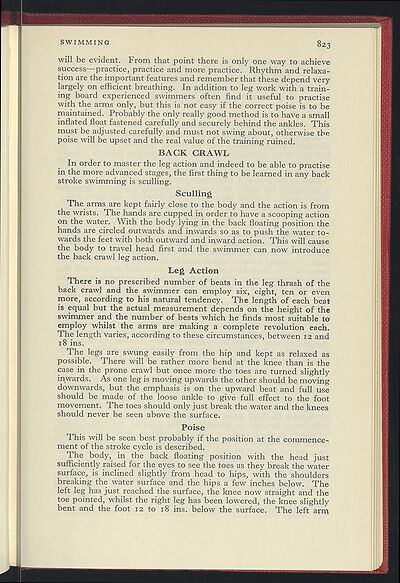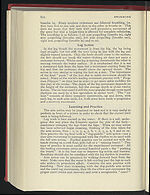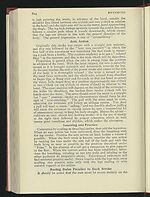1959-60
(899)
Download files
Complete book:
Individual page:
Thumbnail gallery: Grid view | List view

SWIMMING 8
23
will be evident. From that point there is only one way to achieve
success—practice, practice and more practice. Rhythm and relaxa-
tion are the important features and remember that these depend very
largely on efficient breathing. In addition to leg work with a train-
ing board experienced swimmers often find it useful to practise
with the arms only, but this is not easy if the correct poise is to be
maintained. Probably the only really good method is to have a small
inflated float fastened carefully and securely behind the ankles. This
must be adjusted carefully and must not swing about, otherwise the
poise will be upset and the real value of the training ruined.
BACK CRAWL
In order to master the leg action and indeed to be able to practise
in the more advanced stages, the first thing to be learned in any back
stroke swimming is sculling.
Sculling
The arms are kept fairly close to the body and the action is from
the wrists. The hands are cupped in order to have a scooping action
on the water. With the body lying in the back floating position the
hands are circled outwards and inwards so as to push the water to-
wards the feet with both outward and inward action. This will cause
the body to travel head first and the swimmer can now introduce
the back crawl leg action.
Leg Action
There
is no prescribed number of beats in the leg thrash of the
back crawl and the swimmer can employ six, eight, ten or even
more, according to his natural tendency. The length of each beat
is equal but the actual measurement depends on the height of the
swimmer and the number of beats which he finds most suitable to
employ whilst the arms are making a complete revolution each.
The length varies, according to these circumstances, between
12
and
18 ins.
The legs are swung easily from the hip and kept as relaxed as
possible. There will be rather more bend at the knee than is the
case in the prone crawl but once more the toes are turned slightly
in As one leg is moving upw
ar
d
s
th
e
o
th
er
s
h
ou
ld b
e
mov
i
ng
downwards, but the emphasis is on the upward beat and full use
should be made of the loose ankle to give full effect to the foot
movement. The toes should only just break the water and the knees
should never be seen above the surface.
Poise
This will be seen best probably if the position at the commence-
ment of the stroke cycle is described.
The body, in the back floating position with the head just
sufficiently raised for the eyes to see the toes as they break the water
surface, is inclined slightly from head to hips, with the shoulders
breaking the water surface and the hips a few inches below. The
left leg has just reached the surface, the knee now straight and the
toe pointed, whilst the right leg has been lowered, the knee slightly
bent and the foot
12
to 18 ins. below the surface. The left arm
23
will be evident. From that point there is only one way to achieve
success—practice, practice and more practice. Rhythm and relaxa-
tion are the important features and remember that these depend very
largely on efficient breathing. In addition to leg work with a train-
ing board experienced swimmers often find it useful to practise
with the arms only, but this is not easy if the correct poise is to be
maintained. Probably the only really good method is to have a small
inflated float fastened carefully and securely behind the ankles. This
must be adjusted carefully and must not swing about, otherwise the
poise will be upset and the real value of the training ruined.
BACK CRAWL
In order to master the leg action and indeed to be able to practise
in the more advanced stages, the first thing to be learned in any back
stroke swimming is sculling.
Sculling
The arms are kept fairly close to the body and the action is from
the wrists. The hands are cupped in order to have a scooping action
on the water. With the body lying in the back floating position the
hands are circled outwards and inwards so as to push the water to-
wards the feet with both outward and inward action. This will cause
the body to travel head first and the swimmer can now introduce
the back crawl leg action.
Leg Action
There
is no prescribed number of beats in the leg thrash of the
back crawl and the swimmer can employ six, eight, ten or even
more, according to his natural tendency. The length of each beat
is equal but the actual measurement depends on the height of the
swimmer and the number of beats which he finds most suitable to
employ whilst the arms are making a complete revolution each.
The length varies, according to these circumstances, between
12
and
18 ins.
The legs are swung easily from the hip and kept as relaxed as
possible. There will be rather more bend at the knee than is the
case in the prone crawl but once more the toes are turned slightly
in As one leg is moving upw
ar
d
s
th
e
o
th
er
s
h
ou
ld b
e
mov
i
ng
downwards, but the emphasis is on the upward beat and full use
should be made of the loose ankle to give full effect to the foot
movement. The toes should only just break the water and the knees
should never be seen above the surface.
Poise
This will be seen best probably if the position at the commence-
ment of the stroke cycle is described.
The body, in the back floating position with the head just
sufficiently raised for the eyes to see the toes as they break the water
surface, is inclined slightly from head to hips, with the shoulders
breaking the water surface and the hips a few inches below. The
left leg has just reached the surface, the knee now straight and the
toe pointed, whilst the right leg has been lowered, the knee slightly
bent and the foot
12
to 18 ins. below the surface. The left arm
Set display mode to:
![]() Universal Viewer |
Universal Viewer | ![]() Mirador |
Large image | Transcription
Mirador |
Large image | Transcription
| Games and sports in the army > 1959-60 > (899) |
|---|
| Permanent URL | https://digital.nls.uk/248874725 |
|---|
| Description | 'Games and Sports in the Army' was an annual publication produced by the British War Office between the 1930s and 1960s. This included the Second World War. It outlines the rules and regulations for games and sports played by members of the armed forces. It features names and photographs of team members, and examples of contemporary advertising. |
|---|---|
| Shelfmark | GWB.52 |

